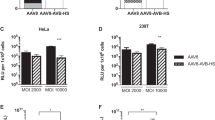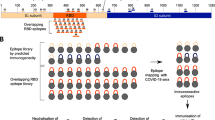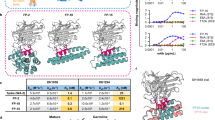Abstract
We report the discovery of AAV capsid-binding peptides identified through phage panning. The heptapeptide motif GYVSRHP selectively recognized AAV serotype 8 capsids and blocked transduction in vitro. Recombinant AAV8 vectors were purified directly from crude cell lysate and supernatant through sequential application of peptide affinity and anion exchange chromatography. Peptide affinity reagents may serve as useful alternatives to monoclonal antibodies in AAV capsid recognition, and offer readily scalable solutions for purification of clinical grade AAV vectors.
This is a preview of subscription content, access via your institution
Access options
Subscribe to this journal
Receive 12 print issues and online access
$259.00 per year
only $21.58 per issue
Buy this article
- Purchase on Springer Link
- Instant access to full article PDF
Prices may be subject to local taxes which are calculated during checkout




Similar content being viewed by others
References
Vandenberghe LH, Breous E, Nam HJ, Gao G, Xiao R, Sandhu A et al. Naturally occurring singleton residues in AAV capsid impact vector performance and illustrate structural constraints. Gene Therapy 2009; 16: 1416–1428.
Mitchell AM, Nicolson SC, Warischalk JK, Samulski RJ . AAV's anatomy: roadmap for optimizing vectors for translational success. Curr Gene Ther 2010; 10: 319–340.
Aucoin MG, Perrier M, Kamen AA . Critical assessment of current adeno-associated viral vector production and quantification methods. Biotechnol Adv 2008; 26: 73–88.
Wright JF . Transient transfection methods for clinical adeno-associated viral vector production. Hum Gene Ther 2009; 20: 698–706.
Clement N, Knop DR, Byrne BJ . Large-scale adeno-associated viral vector production using a herpesvirus-based system enables manufacturing for clinical studies. Hum Gene Ther 2009; 20: 796–806.
Zhang H, Xie J, Xie Q, Wilson JM, Gao G . Adenovirus-adeno-associated virus hybrid for large-scale recombinant adeno-associated virus production. Hum Gene Ther 2009; 20: 922–929.
Virag T, Cecchini S, Kotin RM . Producing recombinant adeno-associated virus in foster cells: overcoming production limitations using a baculovirus-insect cell expression strategy. Hum Gene Ther 2009; 20: 807–817.
Zolotukhin S, Byrne BJ, Mason E, Zolotukhin I, Potter M, Chesnut K et al. Recombinant adeno-associated virus purification using novel methods improves infectious titer and yield. Gene Therapy 1999; 6: 973–985.
Zolotukhin S, Potter M, Zolotukhin I, Sakai Y, Loiler S, Fraites TJ et al. Production and purification of serotype 1, 2, and 5 recombinant adeno-associated viral vectors. Methods 2002; 28: 158–167.
Smith RH, Yang L, Kotin RM . Chromatography-based purification of adeno-associated virus. Methods Mol Biol 2008; 434: 37–54.
Lock M, Alvira M, Vandenberghe LH, Samanta A, Toelen J, Debyser Z et al. Rapid, simple, and versatile manufacturing of recombinant adeno-associated viral vectors at scale. Hum Gene Ther 2010; 21: 1259–1271.
Arnold GS, Sasser AK, Stachler MD, Bartlett JS . Metabolic biotinylation provides a unique platform for the purification and targeting of multiple AAV vector serotypes. Mol Ther 2006; 14: 97–106.
Koerber JT, Jang JH, Yu JH, Kane RS, Schaffer DV . Engineering adeno-associated virus for one-step purification via immobilized metal affinity chromatography. Hum Gene Ther 2007; 18: 367–378.
Smith RH, Levy JR, Kotin RM . A simplified baculovirus-AAV expression vector system coupled with one-step affinity purification yields high-titer rAAV stocks from insect cells. Mol Ther 2009; 17: 1888–1896.
Sergeeva A, Kolonin MG, Molldrem JJ, Pasqualini R, Arap W . Display technologies: application for the discovery of drug and gene delivery agents. Adv Drug Deliv Rev 2006; 58: 1622–1654.
Petrenko V . Evolution of phage display: from bioactive peptides to bioselective nanomaterials. Expert Opin Drug Deliv 2008; 5: 825–836.
Vandenberghe LH, Xiao R, Lock M, Lin J, Korn M, Wilson JM . Efficient serotype-dependent release of functional vector into the culture medium during adeno-associated virus manufacturing. Hum Gene Ther 2010; 21: 1251–1257.
Grieger JC, Choi VW, Samulski RJ . Production and characterization of adeno-associated viral vectors. Nat Protoc 2006; 1: 1412–1428.
Wobus CE, Hugle-Dorr B, Girod A, Petersen G, Hallek M, Kleinschmidt JA . Monoclonal antibodies against the adeno-associated virus type 2 (AAV2) capsid: epitope mapping and identification of capsid domains involved in AAV-2-cell interaction and neutralization of AAV-2 infection. J Virol 2000; 74: 9281–9293.
Rabinowitz JE, Rolling F, Li C, Conrath H, Xiao W, Xiao X et al. Cross-packaging of a single adeno-associated virus (AAV) type 2 vector genome into multiple AAV serotypes enables transduction with broad specificity. J Virol 2002; 76: 791–801.
Acknowledgements
We would like to thank Stephen Soltys at the UNC vector core for assistance with column chromatography and Swati Yadav for qPCR analysis. This study was supported by grants from the American Heart Association, NIH (HL089221) and ARRA funds (HL089221-S1/S2) awarded to AA.
Author information
Authors and Affiliations
Corresponding author
Ethics declarations
Competing interests
The authors declare no conflict of interest.
Additional information
Supplementary Information accompanies the paper on Gene Therapy website
Supplementary information
Rights and permissions
About this article
Cite this article
Pulicherla, N., Asokan, A. Peptide affinity reagents for AAV capsid recognition and purification. Gene Ther 18, 1020–1024 (2011). https://doi.org/10.1038/gt.2011.46
Received:
Revised:
Accepted:
Published:
Issue Date:
DOI: https://doi.org/10.1038/gt.2011.46



